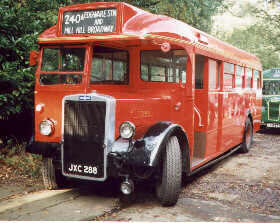
The LONDON TRANSPORT RF FAMILYThis page created 1st December 1997 by Ian Smith, updated 13th June 2001. Best on 800*600.Introduction: The RF, London's versatile bus
RFs in different forms: Greenline coaches, Central Area buses, Country buses, at the RF50 celebrations, 28th May 2001, at Cobham.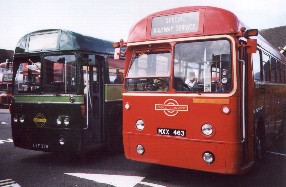 London's RF class of single deckers was an outstanding success,
taking buses forwards from the front-engined designs of pre-war
to a versatile underfloor bus for the fifties and sixties...and seventies.
Versatile they were.
They fulfilled all of London Transport's single decker needs:
urban crewed buses, limited - stop "coach" services and rural bus,
Here is a bus remembered with fondness by those who used them, and by those who crewed them.
They were nice vehicles, perhaps not beautiful,
but with a standard of design that did not date quickly, both outside and in.
They worked, too, which is more than can be said for many of their successors!
London's RF class of single deckers was an outstanding success,
taking buses forwards from the front-engined designs of pre-war
to a versatile underfloor bus for the fifties and sixties...and seventies.
Versatile they were.
They fulfilled all of London Transport's single decker needs:
urban crewed buses, limited - stop "coach" services and rural bus,
Here is a bus remembered with fondness by those who used them, and by those who crewed them.
They were nice vehicles, perhaps not beautiful,
but with a standard of design that did not date quickly, both outside and in.
They worked, too, which is more than can be said for many of their successors!
Red bus and green coach at East Grinstead (preserved, 1998)The background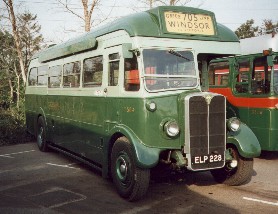 In some ways London Transport was not as desperately short of single-deckers
at the end of the war as it was of double-deckers.
This was because there had been a major programme of single decker
renewal shortly before the war, when the magnificent 10T10 Regals had
replaced much of the Green Line fleet.
There were also still the 9T9s
and the various Q types of reasonable age
and condition.
On the down side, there were still some of the original 1T1s from 1931 still
in service with original bodywork.
The 11T11s might have reasonable bodies, but their chassis were much older,
comparable to the remaining 7T7s, demoted from coach work,
that now trundled around the Kingston area as buses on a weak-bridge route.
In some ways London Transport was not as desperately short of single-deckers
at the end of the war as it was of double-deckers.
This was because there had been a major programme of single decker
renewal shortly before the war, when the magnificent 10T10 Regals had
replaced much of the Green Line fleet.
There were also still the 9T9s
and the various Q types of reasonable age
and condition.
On the down side, there were still some of the original 1T1s from 1931 still
in service with original bodywork.
The 11T11s might have reasonable bodies, but their chassis were much older,
comparable to the remaining 7T7s, demoted from coach work,
that now trundled around the Kingston area as buses on a weak-bridge route.
Preserved 10T10: Cobham's T504
Post war Tiger: preserved 2TD2: Cobham's TD95The grand standardisation plan looked for a replacement that could handle all these types of traffic: private hire, Green Line, country bus and city bus. Experiences with the various Q type single-decker buses had been good, but the offside engine with its anti-clockwise motion had produced lopsided handling and maintenance headaches. The TF with its offset underfloor engine had been a success. The next logical step was a high-floor bus with a centrally mounted engine underneath. AEC produced a Regal IV prototype, UMP 227. London Transport tried it out on the Country Area 355 route from St Albans, and was impressed. The RF concept was born! (UMP 227 survives, preserved at Cobham Museum). 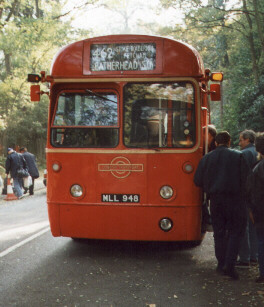
The most immediate problem was a fleet of private hire coaches for the Festival of Britain in 1951. In the event there were two fleets: the private hire RFs and the wider RFWs. After that were Green Line RFs to relieve the 10T10s and 6Q6s from the coaching duties, allowing those to be cascaded to Central bus work, releasing older Ts for sale. A large batch of Central Area RFs followed, replacing everything in the Central Area, except for the postwar Ts and TDs. Right: preserved 'Central Area' RF: RF530 on the Cobham - Leatherhead service, RF Running Day, 27th Oct 1997The Country Area followed on, ending up with the RFs, the small GSs and a handful of 15T13s to handle all its single-decker traffic. But that was not the complete RF fleet for London Transport.
They also operated a fleet of specialist RFs on behalf of British European Airways,
on airport services between London and Heathrow Airport.
Contents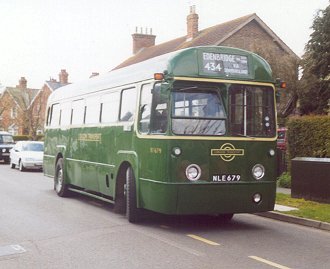
Preserved RF679 at the Hilders Lane terminus of the 434 at Edenbridge, on the 2001 East Grinstead Running Day. Photo by Ian Smith. Ian's Bus Stop Ian's Bus Stop
 RF Contents RF Contents
 Private Hire RFs Private Hire RFs
|
